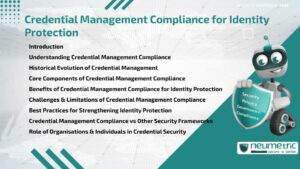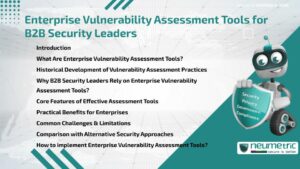Table of Contents
ToggleIntroduction
Enterprise Vulnerability Assessment tools are essential for B2B security leaders tasked with protecting sensitive Systems & Data. These tools identify, classify & prioritise Security Gaps across networks, applications & endpoints. By using them, enterprises can streamline Risk Management, ensure Regulatory Compliance & maintain trust with Stakeholders. This article explores their history, practical benefits, features, limitations & how B2B security leaders can apply them effectively.
What Are Enterprise Vulnerability Assessment Tools?
Enterprise Vulnerability Assessment tools are software solutions designed to scan systems & detect weaknesses before malicious actors exploit them. They provide actionable insights by ranking Vulnerabilities based on severity & potential impact. Much like a health check-up, they act as an early warning system that enables enterprises to address issues proactively rather than reactively.
Historical Development of Vulnerability Assessment Practices
The concept of Vulnerability Assessment emerged alongside the rise of digital networks in the late twentieth century. Early practices were manual, relying on administrators to review configurations & logs. As Threats evolved, automated scanning tools became vital. Today, enterprise Vulnerability Assessment tools integrate advanced analytics & align with standards such as the NIST Cybersecurity Framework & ISO 27001, ensuring structured & consistent Security Monitoring.
Why B2B Security Leaders Rely on Enterprise Vulnerability Assessment Tools?
B2B environments often involve large-scale operations, complex vendor networks & sensitive Customer Data. Enterprise Vulnerability Assessment tools help leaders:
- Detect Vulnerabilities before attackers exploit them
- Monitor Third Party Risks in supply chains
- Demonstrate compliance with regulations like HIPAA & GDPR
- Reduce reputational damage by preventing breaches
These tools provide the visibility & accountability that B2B enterprises require in highly interconnected markets.
Core Features of Effective Assessment Tools
An effective enterprise Vulnerability Assessment tool typically includes:
- Automated scanning of systems & applications
- Risk prioritisation with scoring mechanisms
- Integration with Patch Management & Incident Response systems
- Real-time dashboards & reporting capabilities
- Support for compliance frameworks & regulatory audits
These features allow security leaders to identify, respond to & monitor Vulnerabilities in a structured manner.
Practical Benefits for Enterprises
By adopting enterprise Vulnerability Assessment tools, Organisations gain:
- Efficiency: Automated scanning reduces manual workload
- Consistency: standardised methods improve Audit readiness
- Risk Reduction: Proactive Vulnerability management lowers attack exposure
- Cost Savings: Prevents costly breaches & downtime
- Trust: Strengthens relationships with B2B clients by showcasing strong security practices
Common Challenges & Limitations
Despite their strengths, enterprise Vulnerability Assessment tools face several challenges:
- False positives that can overwhelm security teams
- Limited visibility into custom-built applications
- High licensing or integration costs for large enterprises
- Risk of over-reliance without complementary security practices
Acknowledging these limitations ensures that enterprises use the tools effectively within a broader security strategy.
Comparison with Alternative Security Approaches
Some Organisations focus on Penetration Testing or external audits. While valuable, these methods are point-in-time assessments. Enterprise Vulnerability Assessment tools, however, offer Continuous Monitoring. By combining both approaches, B2B security leaders achieve a balance between external validation & internal vigilance.
How to implement Enterprise Vulnerability Assessment Tools?
Enterprises should begin by defining their security objectives & compliance needs. Once selected, tools should be integrated with existing workflows, such as Patch Management & Incident Response. Training staff ensures that results are interpreted accurately. Leaders can also consult resources from ISACA & SANS Institute for implementation guidance.
Conclusion
Enterprise Vulnerability Assessment tools are Critical Assets for B2B security leaders. They provide visibility, prioritise Risks & support compliance while empowering enterprises to strengthen their security posture. With proper implementation, these tools serve as a cornerstone of effective Risk Management.
Takeaways
- Enterprise Vulnerability Assessment tools identify, classify & prioritise Vulnerabilities across systems.
- They improve efficiency, compliance & trust in B2B relationships.
- Limitations such as false positives & costs must be managed.
- Combining tools with other approaches creates a stronger security strategy.
FAQ
What do enterprise Vulnerability Assessment tools do?
They scan systems, detect weaknesses & provide actionable insights for Risk Management.
How often should enterprises run Vulnerability assessments?
Ideally, assessments should be run continuously, with major scans performed monthly or quarterly.
Are Vulnerability Assessment tools the same as penetration tests?
No, tools provide automated, Continuous Monitoring, while penetration tests simulate real-world attacks.
Do these tools support Compliance Requirements?
Yes, they align with frameworks like ISO 27001, NIST & HIPAA to support Regulatory Compliance.
Can small enterprises use the same tools as large Organisations?
Yes, though they may scale differently depending on licensing & infrastructure.
What are the biggest limitations of these tools?
False positives, limited customization visibility & integration costs are common issues.
How do B2B leaders benefit from adopting these tools?
They gain trust, reduce Risks & strengthen security in vendor & Client relationships.
Need help for Security, Privacy, Governance & VAPT?
Neumetric provides organisations the necessary help to achieve their Cybersecurity, Compliance, Governance, Privacy, Certifications & Pentesting needs.
Organisations & Businesses, specifically those which provide SaaS & AI Solutions in the Fintech, BFSI & other regulated sectors, usually need a Cybersecurity Partner for meeting & maintaining the ongoing Security & Privacy needs & requirements of their Enterprise Clients & Privacy conscious Customers.
SOC 2, ISO 27001, ISO 42001, NIST, HIPAA, HECVAT, EU GDPR are some of the Frameworks that are served by Fusion – a SaaS, multimodular, multitenant, centralised, automated, Cybersecurity & Compliance Management system.
Neumetric also provides Expert Services for technical security which covers VAPT for Web Applications, APIs, iOS & Android Mobile Apps, Security Testing for AWS & other Cloud Environments & Cloud Infrastructure & other similar scopes.
Reach out to us by Email or filling out the Contact Form…





